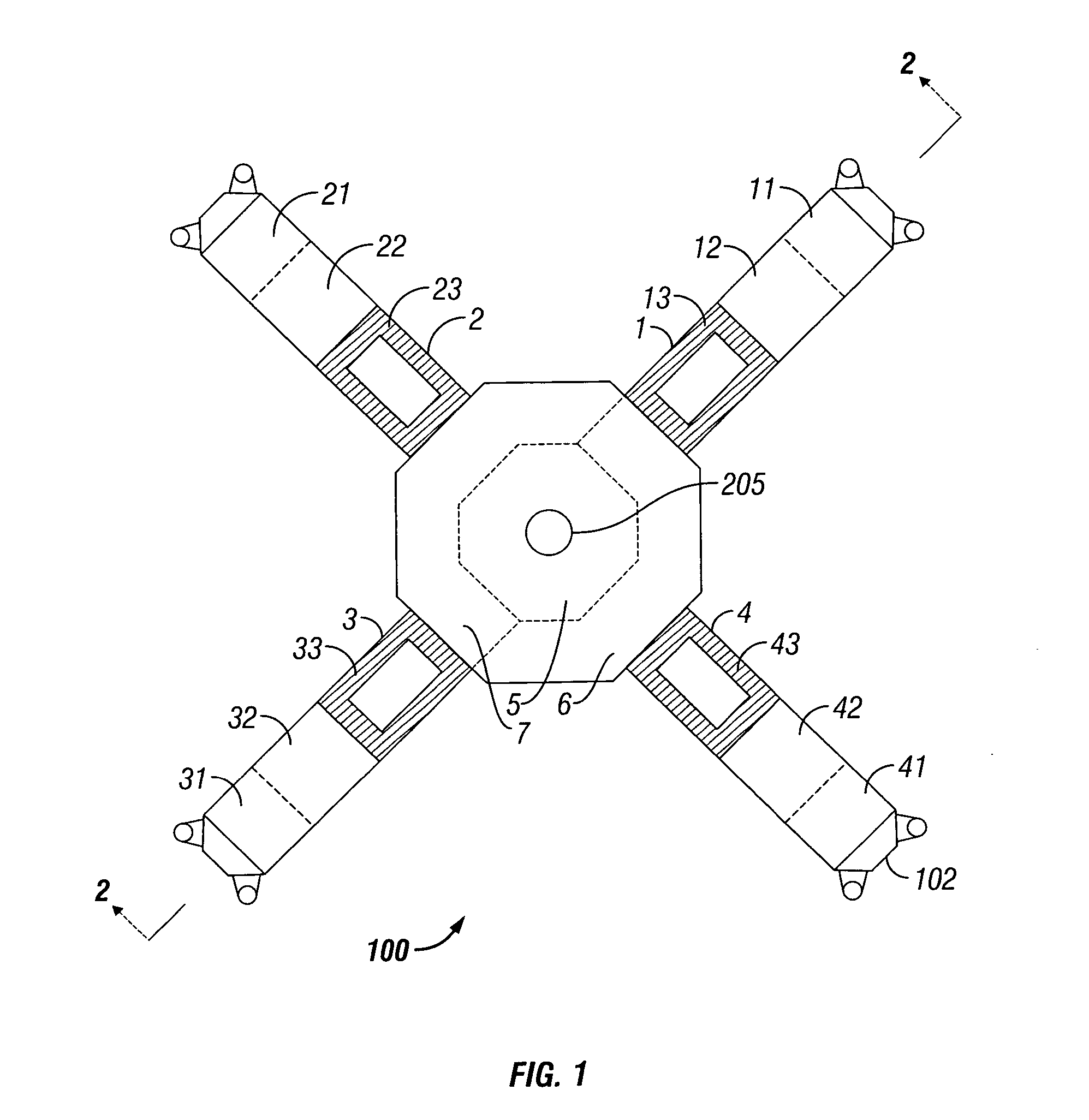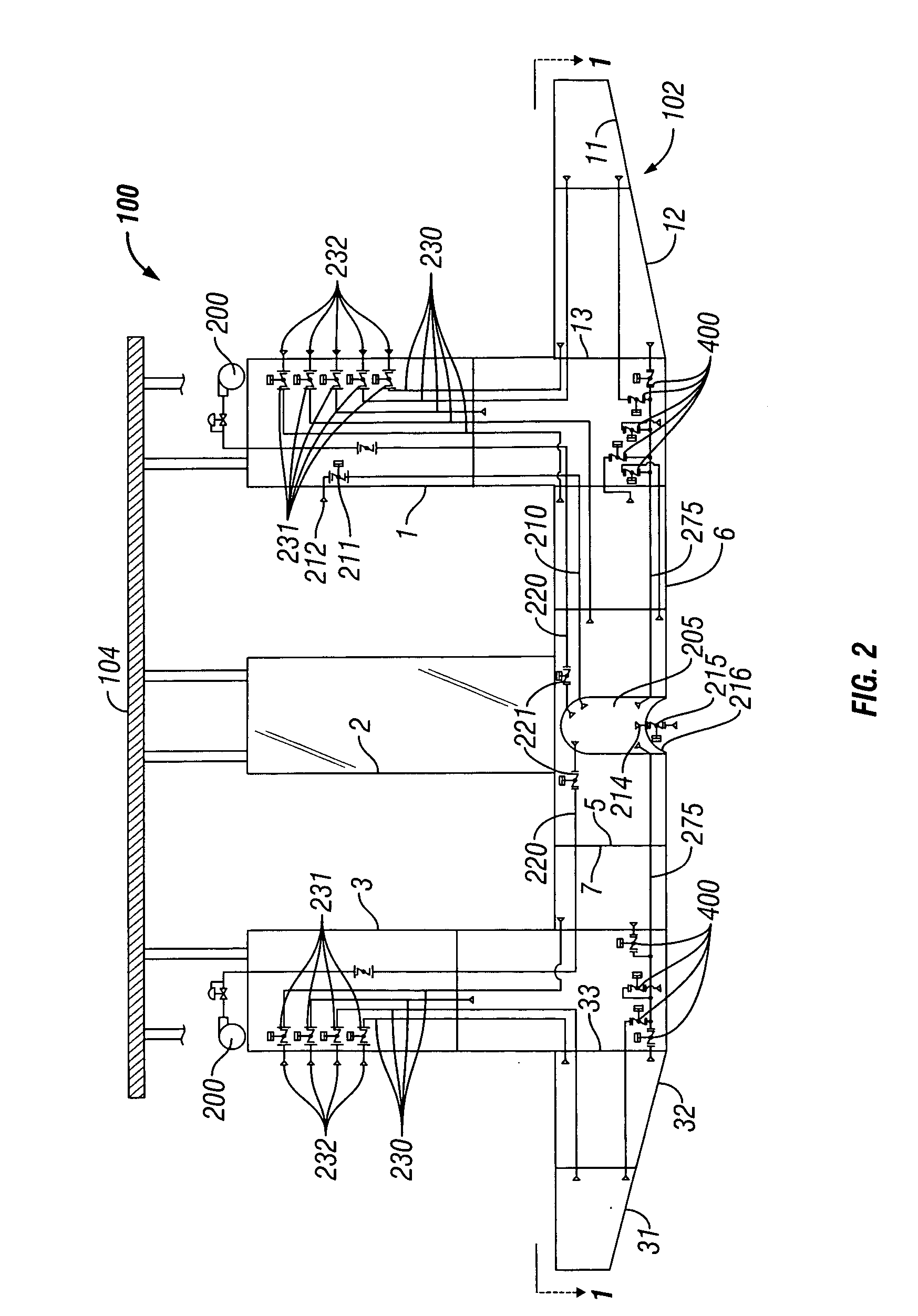Ballast system for tension leg platform
a technology of ballast tank and leg platform, which is applied in the direction of underwater equipment, special-purpose vessels, vessel construction, etc., can solve the problems of high-capacity requirements, and achieve the effect of rapid flooding of ballast tanks and achieving installation dra
- Summary
- Abstract
- Description
- Claims
- Application Information
AI Technical Summary
Benefits of technology
Problems solved by technology
Method used
Image
Examples
first embodiment
[0023] As shown in FIG. 1, the ballast and de-ballast system according to the invention is preferably employed in a tension leg platform (TLP) 100 having a hull 102 and a number of columns 1, 2, 3, 4 extending upwardly therefrom and supporting a deck 104. The hull 102 has any number of internal ballast tanks but is illustrated with fifteen internal ballast tanks. There are four permanent ballast tanks 11, 21, 31, 41 that are the most outboard tanks in the hull 102. There are eleven tanks within the hull 102 used only temporarily for towing and installation of the TLP to the tendons: Four of these temporary ballast tanks 12, 22, 32, 42 are located immediately inboard of the four permanent ballast tanks 11, 21, 31, 41; four temporary ballast tanks 13, 23, 33, 43 are located at the base of the columns 1, 2, 3, 4, respectively; the three central tanks are the base center tank 5, the wing tank east 6, and the wing tank west 7. However, the ballast / de-ballast system and method may be used...
second embodiment
[0029] As shown in FIG. 5, a second embodiment the ballast and de-ballast system and method according to the invention is preferably employed in a tension leg platform (TLP) 100 having a hull 102 and a number columns 1, 2, 3, 4 extending upwardly therefrom and supporting a deck 104. The hull 102 has any number of internal ballast tanks but is illustrated with sixteen internal ballast tanks. There are four permanent ballast tanks 11, 21, 31, 41 that are the most outboard tanks in the hull 102. There are twelve tanks within the hull 102 used only temporarily for towing and installation of the TLP 100 to the tendons: Four of these temporary ballast tanks 12, 22, 32, 42 are located immediately inboard of the four permanent ballast tanks 11, 21, 31, 41; four temporary ballast tanks 13, 23, 33, 43 are located at the base of the columns 1, 2, 3, 4, respectively; and four tanks are central base tanks 14, 24, 34, 44. However, the ballast / de-ballast system and method may be used with other ve...
third embodiment
[0033]FIG. 7 illustrates the invention. In this system, ballasting and de-ballasting occur through a ballasting manifold system 730 rather than through individual sea chests. The ballasting manifold 730 is preferably located near the keel level. The ballasting manifold 730 is fluidly coupled to the individual ballast tanks 11, 12, 14, 31, 32, 34 with ballast compartment isolation valves 735 connected therebetween for selective isolation. The ballasting manifold 730 is also fluidly coupled to an overboard discharge line 740 with an overboard discharge valve 745 connected therein to allow isolation, and the ballasting manifold 730 is fluidly coupled to a topsides seawater main 750 by seawater isolation valve 755. Each ballast tank is preferably individually vented to atmosphere through discharge openings 701, vent isolation valves 715, and vent piping 716. A compressed gas header 702 ties into tank vents with gas isolation valves 720. A source of compressed gas 200, preferably a high ...
PUM
 Login to View More
Login to View More Abstract
Description
Claims
Application Information
 Login to View More
Login to View More - R&D
- Intellectual Property
- Life Sciences
- Materials
- Tech Scout
- Unparalleled Data Quality
- Higher Quality Content
- 60% Fewer Hallucinations
Browse by: Latest US Patents, China's latest patents, Technical Efficacy Thesaurus, Application Domain, Technology Topic, Popular Technical Reports.
© 2025 PatSnap. All rights reserved.Legal|Privacy policy|Modern Slavery Act Transparency Statement|Sitemap|About US| Contact US: help@patsnap.com



